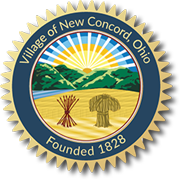Overview
The Village of New Concord, Ohio was laid out on March 24, 1827. The evolution of the village most certainly centered on the establishment of the famous National Road (now known as U.S. Route 40). The village was officially incorporated in 1838. The first church established with the aid of David Findley was known as The United Presbyterian situated on Crooked Creek one mile southwest of the Village. Other churches soon followed with the growth of the community. Currently there are two Presbyterian churches, two Baptist Churches, The New Concord Methodist Church and the New Concord Church of Christ.
No mention of the Village of New Concord would be complete without telling of the founding of Muskingum College in 1837. The first class graduated in 1839 and classes have continued with the mark of progress ever since. In 2003 Muskingum College enrolled over 1,500 students. By 2000, New Concord’s population reached 2,556.
Geographically, New Concord is in east central Ohio, 75 miles east of Columbus, Ohio and 75 miles west of Wheeling, West Virginia. New Concord is located on Interstate 70 and is 8 miles west of Interstate 77 at Cambridge, Ohio, which is 130 miles south of Cleveland. The terrain is gently rolling hills that is predominantly occupied by farms and wooded areas. Many State Parks and outdoor attractions are located nearby.
Muskingum University remains the center of business in New Concord. However, several corporate offices and service companies are now located in the Village. The East Muskingum School District and John Glenn High School, named after New Concord’s most famous native, are located at the north edge of the village. The John and Annie Glenn Historic Site, the William Rainey Harper Cabin and historic “S” Bridge are also located in the Village

